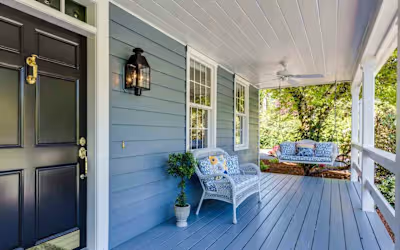Can you get a HELOC on an investment property?
Like this project
Posted Jan 3, 2024
Interested in taking out a HELOC on an investment property? Learn more about the risks and benefits of getting a HELOC on an investment property.
Likes
0
Views
7
Home equity lines of credit (HELOCs) allow homeowners to access funds needed for home renovations, college tuition, medical bills, or other unexpected expenses. Since most people have just one home, HELOCs are usually taken out on a borrower’s primary residence. However, it’s possible to take out a HELOC on an investment property. The catch is that HELOCs on investment properties come with stricter requirements, aren’t widely available, and are hard to qualify for.
In this blog, we’ll review what a HELOC is, how it works, the pros and cons of taking one out, and how to determine if obtaining a HELOC on an investment property is a good idea.
What is a HELOC?
A HELOC is a financial product that allows homeowners to borrow money using their home’s equity as collateral. HELOCs are attractive funding options because they usually come with less interest than a credit card or personal loan.
HELOCs act as revolving lines of credit, allowing homeowners to access funds during an initial draw period of about 10 years. During that time, borrowers make small, interest-only payments. After the draw period has passed, borrowers begin to repay the balance owed through larger monthly payments.
Investment property HELOCs work similarly to HELOCs on a primary residence. However, when you apply for a home equity line of credit, investment property requirements can be even more strict than the requirements for an ordinary HELOC. HELOCs on investment properties also tend to be more expensive.
How does a HELOC on an investment property work?
Getting approved for a HELOC on an investment property is generally the same process as getting approved for a HELOC on a primary residence. However, not all lenders offer HELOCs on investment properties. The lenders that do, often have strict borrowing requirements. Nonetheless, here is what you need to know about getting approved for an investment property HELOC, and how an investment property line of credit differs from a traditional HELOC.
Equity
Lenders usually require HELOC borrowers to have a minimum of 15-20% home equity stake and will allow you to borrow up to 85% of your home’s total equity. With a HELOC on an investment property, equity requirements are slightly different. Lenders will want to see a loan-to-value ratio (LTV) of no more than 75% to 80%. This means that outstanding loans on the property, including the mortgage, cannot surpass 75% to 80% of the property’s overall value.
Credit score
A good credit score is necessary for all types of financing, but especially investment property HELOCs. With HELOCs on primary residences, lenders might be more willing to weigh credit scores against other financial factors such as income. With HELOCs on investment properties, lenders prefer to see a credit score of 720, or higher. It’s important to keep a good credit score in order to get approved, although it’s possible to get approved for a HELOC with a low credit score.
Cash reserves
Another factor that influences whether or not a borrower gets approved for an investment property HELOC is the amount they have in personal cash reserves. Lenders prefer to see six months' worth of expenses to make sure a borrower is capable of keeping up with their payments in case of a financial emergency. With a HELOC on a primary residence, the required minimum cash reserves are usually less.
When getting a HELOC on an investment property makes sense
There are a few instances where taking out a HELOC on an investment property is especially beneficial, such as when you use the funds to improve your investment property. Not only can this increase your property value, but it also comes with certain tax benefits. A HELOC on an investment property may also be a smart choice if rates are low, given that interest rates on investment property HELOCs are usually lower than regular HELOCs. Take a closer look at these scenarios below.
Taking out an investment property HELOC for home improvements
If you take out an investment property HELOC to fund a home remodeling project, the monthly interest payments you make on a HELOC are tax-deductible. Investors will often take out a HELOC on an existing rental property and use the funds as a down payment on future rental properties. Although this doesn’t guarantee tax benefits, it’s a smart strategy that can double or triple rental income for a real estate investor.
Taking out an investment property HELOC when rates are low
Given that a HELOC is secured by an asset, it usually comes with lower interest rates than an unsecured personal loan or credit card. From a lender’s perspective, it’s less risky to lend to a borrower with collateral than a borrower with an excellent credit score. Of course, having both increases your chances of getting approved. However, lenders can offer better terms to borrowers with less-than-perfect credit scores simply because the line of credit is secured by a property.
Considerations for getting a HELOC on an investment property
While HELOCs come with many benefits, they aren’t void of risks. If you default on your HELOC payments your investment property could enter foreclosure. Not only does this mean you could lose your house, but also the rental income it generates.
In theory, a HELOC on a primary residence and a HELOC on an investment property work similarly. However, the process of taking one out differs depending on what kind of property you are using to secure your HELOC. Here are three disadvantages to consider before taking out a HELOC on your investment property.
They’re riskier, so they’re more expensive
Lenders consider HELOCs on an investment property riskier than HELOCs on primary residences. This is because the borrower is responsible for two mortgage payments instead of one, increasing the risk of defaulting on payments. As a result, lenders tend to charge HELOC borrowers with investment properties more in interest and fees than traditional HELOC borrowers.
Lending criteria are stricter
As mentioned above, HELOCs on investment properties come with more stringent application requirements than HELOCs on primary residences. Here’s a list of the criteria borrowers need to meet:
Excellent credit (720+)
Debt-to-income ratio of 40-50%
Maximum loan-to-value ratio of 80%
6 months of cash reserves or more
Consistent monthly income from tenants
Additional features validate the property’s profitability, such as long-term tenants or multiple home appraisals.
Lenders are scarce
In addition to being hard to qualify for, HELOCs on investment properties are also hard to come by. Not all lenders offer investment property HELOCs. As a result, shopping around for competitive terms and rates can be difficult.
Alternatives to HELOC on investment property
Given the many requirements that come with taking out a HELOC on an investment property, it’s worth considering other financing options. Here are three equity-based funding alternatives to a HELOC:
Cash-out refinance
A cash-out refinance allows you to refinance the mortgage on your property for a higher amount and take out the difference in cash. Keep in mind that when you refinance your mortgage, a new interest rate is set. It’s best to obtain a cash-out refinance when interest rates are low.
Home equity loan
A home equity loan works similarly to a home equity line of credit, except instead of a credit card, borrowers receive a lump sum of cash. The loan usually comes with fixed rates and monthly payments. However, as with HELOCs on investment properties, home equity loans on investment properties are scarce and often come with higher interest rates than home equity loans on primary residences.
Home Equity Investment
A Home Equity Investment (HEI) allows you to access a lump sum with no monthly payments. It’s a smart choice for homeowners with less-than-perfect credit scores who need to access between $25k and $500k. There are no restrictions as to how the funds can be used and payment is settled either when the house is sold, or when the borrower decides to end the agreement.
Final thoughts on investment property HELOCs
Taking out an investment property HELOC can be a wise decision if you meet the qualifying criteria. However, if you have a low credit score, insufficient rental income, or a high debt-to-income ratio, it might be hard to get approved.
Consider a home equity investment instead. Point’s HEI allows borrowers to enter into an equity-sharing agreement where they receive the funds they need upfront in exchange for a percentage of their home equity. Visit Point to find out if you qualify for an HEI and start financing your ongoing expenses, today.







